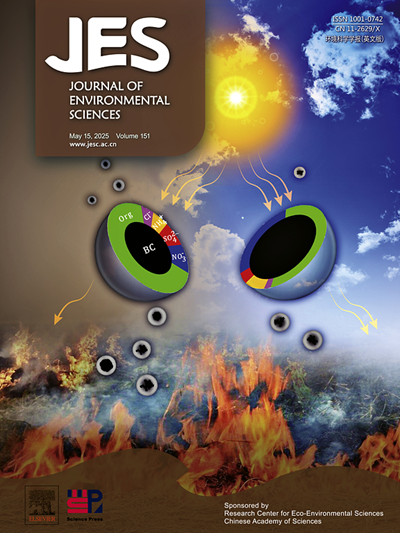Roles of naturally occurring biogenic iron-manganese oxides (BFMO) in PMS-based environmental remediation: A complete electron transfer pathway
IF 5.9
2区 环境科学与生态学
Q1 ENVIRONMENTAL SCIENCES
引用次数: 0
Abstract
Bisphenol A (BPA) is a pervasive endocrine disruptor that enters the environment through anthropogenic activities, posing significant risks to ecosystems and human health. Advanced oxidation processes (AOPs) are promising methods for the removal of organic microcontaminants in the environment. Biogenic manganese oxides (BMO) are reported as catalysts due to their transition metal nature, and are also readily generated by manganese-oxidizing microorganisms in the natural environment, and therefore their roles and effects in AOPs-based environmental remediation should be investigated. However, biogenic iron-manganese oxides (BFMO) are actually generated rather than BMO due to the coexistence of ferrous ions which can be oxidized to iron oxides. Therefore, this study produced BFMO originating from a highly efficient manganese-oxidizing fungus Cladosporium sp. XM01 and chose peroxymonosulfate (PMS) as a typical oxidant for the degradation of bisphenol A (BPA), a model organic micropollutant. Characterization results indicate that the formed BFMO was amorphous with a low crystallinity. The BFMO/PMS system achieved a high degradation performance that 85 % BPA was rapidly degraded within 60 min, and therefore the contribution of BFMO cannot be ignored during PMS-based environmental remediation. Different from the findings of previous studies (mostly radicals and singlet oxygen), the degradation mechanism was first proven as a 100 % electron-transfer pathway mediated by high-valence Mn under acidic conditions provided by PMS. The findings of this study provide new insights into the degradation mechanisms of pollutants using biogenic metal oxides in PMS activation and the contribution of their coexistence in AOPs-based environmental remediation.

求助全文
约1分钟内获得全文
求助全文
来源期刊

Journal of Environmental Sciences-china
环境科学-环境科学
CiteScore
13.70
自引率
0.00%
发文量
6354
审稿时长
2.6 months
期刊介绍:
The Journal of Environmental Sciences is an international journal started in 1989. The journal is devoted to publish original, peer-reviewed research papers on main aspects of environmental sciences, such as environmental chemistry, environmental biology, ecology, geosciences and environmental physics. Appropriate subjects include basic and applied research on atmospheric, terrestrial and aquatic environments, pollution control and abatement technology, conservation of natural resources, environmental health and toxicology. Announcements of international environmental science meetings and other recent information are also included.
 求助内容:
求助内容: 应助结果提醒方式:
应助结果提醒方式:


